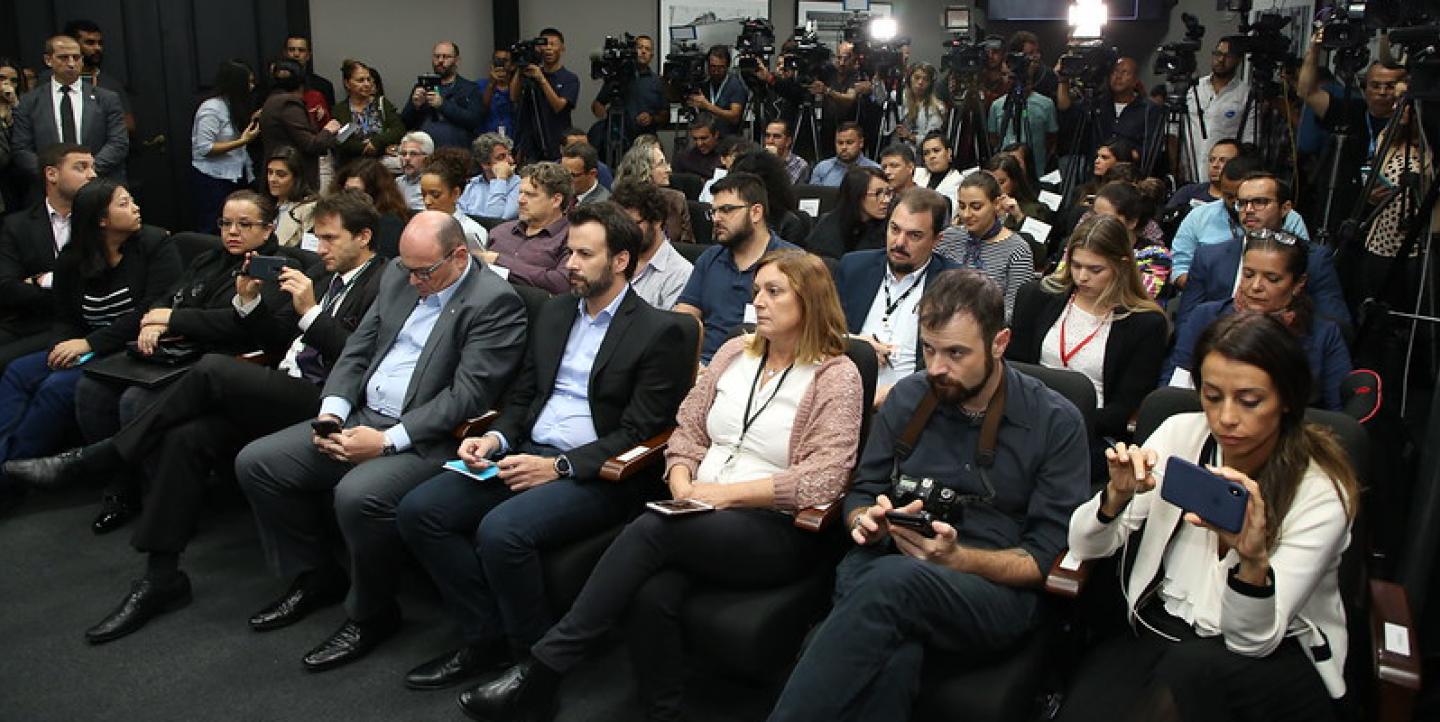Brazil recorded its first case of the novel coronavirus on Feb. 26. As of March 24, that number has been climbing rapidly to 2,018 cases and 34 deaths.
But on the eve of school closings in São Paulo and Rio de Janeiro, and despite health agencies urging for social distancing, President Jair Bolsonaro participated in a pro-government demonstration in which he was in contact with hundreds of citizens and journalists. In an interview with newly launched CNN Brasil, Bolsonaro called preventive measures, such as banning mass events, "hysteria."
Bolsonaro himself has taken a coronavirus test, and at least 22 members of the Brazilian delegation that traveled to the United States in February contracted the coronavirus.
Journalist Marina Dias from Folha de S. Paulo, who covered part of Bolsonaro's trip, decided to self-isolate. According to her account, the Washington meeting she attended in a windowless room full of people could not have been more conducive to the transmission of the virus.
Meanwhile, journalism as a public service is vital and doesn't stop. Journalists are still covering press conferences and conducting on-the-ground reporting. How can they protect themselves from contracting the disease?
[Read more: 10 tips for journalists covering COVID-19]
Following the World Health Organization's lead, Brazil's Ministry of Health published guidelines for all businesses in the country, including the media. The guidelines recommend virtual meetings and canceling non-essential trips, and encourage employees to work from home if possible. Managers are advised to adopt alternative schedules so that workers could avoid peak commuting hours.
Many Brazilian news outlets are implementing preventive measures, while intensifying their coverage of the pandemic. The largest newspapers, including Folha de S. Paulo, O Estado de S. Paulo and O Globo, have encouraged their employees to work remotely.
For journalists who remain in the newsrooms, Dr. Jamal Suleiman, an infectious disease specialist at the Emílio Ribas Institute in São Paulo, recommends maintaining several feet of distance between you and other people, including between newscasters and interviewees.
"As soon as you get to work, you should clean your things [such as your computer] with 70% alcohol," he says. "When finished, wash your hands and then start working and do the same before leaving."
Despite taking all these precautions to reduce the exposure to the virus, Suleiman stresses, individuals can still be exposed.
Guidelines for on-the-ground reporting
Last Monday, the Union of Professional Journalists in the State of São Paulo (SJSP in Portuguese) issued guidelines for news outlets recommending that face-to-face interviews should only take place if strictly necessary, and all business trips that are nonessential for news coverage should be canceled.
The guidelines are more doable for digital outlets that are used to working remotely than for photojournalists and videographers. Visual journalists are instructed to rely on interviews via video conference, and when that is not possible, choose a location with fewer people and ensure that no one has cold or flu symptoms.
Dr. Suleiman says that open spaces are no longer deemed safe. "Agglomeration is a problem. There are some studies about the viability of the virus in the air, which is two [or three] hours. How much of that has an impact? We still have no idea,” he explains. Therefore, ideally, choose places where few people have circulated.
For street interviews, where one cannot ascertain if interviewees are carriers or not, wear a surgical mask. “Use it and discard it. The duration of the mask is two hours, but you will not spend two hours interviewing the same person, so for each interviewee, [use] a different mask,” he advises.
Dr. Suleiman says he remembers that in the 1990s when HIV cases broke out in Brazil, the television teams were huge, with four or five people. Today he considers a small team of a maximum of two ideal for covering epidemics, which reduces the likelihood of widespread infection.
For the equipment, reporters are advised to use two microphones, one for themselves and one for the interviewee, and clean all the equipment with alcohol. For on-the-ground teams, TV Globo distributed a kit containing hand sanitizer and Lysoform to disinfect the equipment.
“We do not interview people with symptoms and try to keep a safe distance from interviewees. In addition, we encourage user-generated content, such as videos from hospitals, that are then verified by journalists,” says a spokesperson from TV Globo via e-mail.
Last week, the Ministry of Health decided to hold its press conferences through videoconference and WhatsApp. Yet, President Bolsonaro continues to minimize the risks of the pandemic and schedule face-to-face interviews.
[Read more: Everyone's a health reporter now: Covering COVID-19 on other beats]
COVID-19 prevention tips for journalists:
- Work from home if you can
- In the newsroom, clean your work station every day with at least 70% alcohol
- Wash your hands regularly for at least 20 seconds
- Conduct in-person interviews only if necessary
- Keep a distance of at least three to six feet from interviewees
- Use two microphones and sanitize them with alcohol and disposable towels
- Clean all equipment with alcohol
- Send teams of no more than two people
- Opt for places with low foot traffic
- Wear a surgical mask when interviewing random people on the streets and discard it immediately after
Main image CC-licensed by Flickr via Governo do Estado de São Paulo: Coronavirus press conference Feb. 27 in São Paulo.

